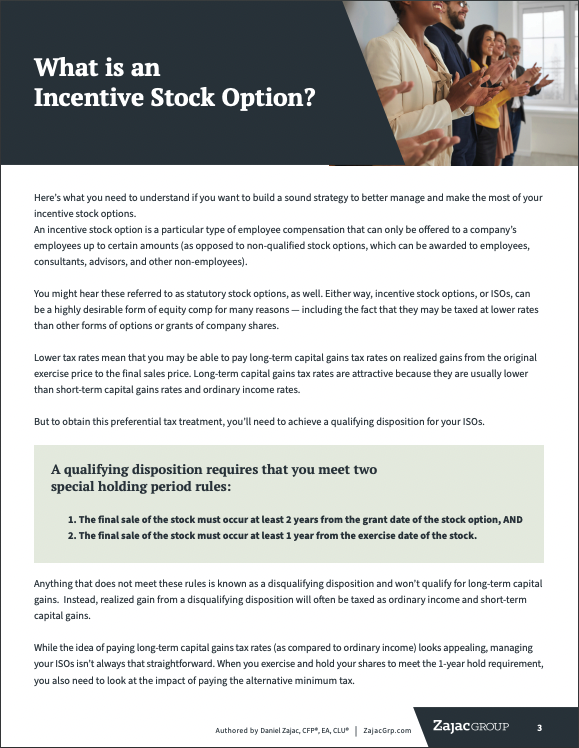Incentive stock options (ISOs) are known for their preferential tax treatment on the total recognized gain—as long as you meet the holding period requirements for a qualified sale. As a reminder, they aren’t subject to ordinary income tax or payroll tax when exercised. If you hold the exercised options for long enough (two years after the ISOs are granted and one year after exercising), any gain between the strike price and sale price may only be subject to long-term capital gains tax (in the event of a qualified sale).
If you are unfamiliar with the basics of incentive stock options, I recommend starting here.
This preferential tax treatment is a primary reason so many employees are willing to exercise and hold their ISOs, possibly incur alternative minimum tax (AMT), and assume the concentration and volatility risk that can happen when holding a single stock outright.
But how valuable is the lower tax rate of long-term capital gains when compared to ordinary income? The short answer is, it depends.
I’ve written extensively on AMT and ISOs, even calling this delta a “buffer” (referring to the difference between the tax rates for a qualified sale and a disqualified sale). However, this article does not cover how that buffer may change based on the total household income for the same calendar year.
Why Your Wage Impacts the Tax “Buffer”
Generally speaking, a lower income will result in a smaller potential tax buffer. The opposite is true as well—a higher income may lead to a potentially larger tax buffer.
FREE GUIDE
The Ultimate Guide to Incentive Stock Options
Learn the ins and outs of incentive stock options so you gain a better understanding of what you have.
The takeaway? If you’re primarily interested in exercising and holding ISOs solely for the long-term capital gains tax benefit, this benefit may be meaningfully smaller than expected depending on your income.
All of this to say, the single biggest driver of future wealth often isn’t the tax “savings” of a qualified sale, but rather the final price at which you sell your stock.
Exploring the Tax Buffer of Incentive Stock Options
In its most simple terms, the exercise and sale of ISOs can result in one of two outcomes: Either a disqualified sale (which is often taxed as ordinary income) or a qualified sale (which is often taxed as long-term capital gains).
As a review:
- Ordinary Income Tax Rates: Ordinary income is a progressive tax system of seven tax brackets, ranging from 10% to 37%.1 Your taxable income and filing status, amongst other things, will determine how much of your income is taxed at which rate, and how much tax you will pay.
- Long-Term Capital Gain (LTCG) Tax Rates: Capital assets, such as stock (in our example), are taxed at one of three rates in 2024: 0%, 15%, or 20%.2 Your specific long-term capital gain tax rate will depend on your overall taxable income—the higher your taxable income, the higher your LTCG rate (capped at 20%)
- Net Investment Income Tax (NIIT): This is a separate tax on investment-related activities for taxpayers with income above certain levels. Long-term capital gain income from the sale of ISOs may be subject to a NIIT 3.8% tax rate.3
Using the highest tax rates available in both categories (37% ordinary income and 20% long-term capital gain tax), we can easily estimate the potential benefit of a qualified sale.
“Tax Buffer” = “Ordinary Income Rate” less “LTCG Rates”
= 37% – 20%
= 17%
In this example, the potential benefit of a qualified sale can be estimated at 17%.
However, if we review the tax rates and assume something different, say a 24% ordinary income tax rate vs. a 15% long-term capital gains rate, the delta drops to 9%. This nearly 50% reduction in the tax benefit makes a qualified sale less intriguing.
Exploring ISO Tax Buffer with Actual Incomes
One way to explore the tax buffer on a qualified sale is to illustrate and explain the taxation of ISOs over two years. More specifically, we can look at how the gain associated with ISOs is taxed, and at what rates, in both a disqualified sale and a qualified sale. We can then compare the two, calculating an actual tax buffer based on a specific scenario.
An aside: Specifically, and unlike many other articles about ISOs, we are going to remove AMT from the situation. I think it’s reasonable to assume that AMT is often a temporary prepayment of tax due, one that will be returned over time. As such, it’s a net-neutral event from a tax-paid standpoint.
To get started, let’s make a few simple assumptions. The hypothetical investor in this scenario is:
- Filing taxes as “Married Filing Jointly” (MFJ)
- Using the standard deduction
- Has 10,0000 Incentive stock options
- Strike Price: $1
- Fair market value (FMV) at exercise: $26
- FMV at sale: $26 (regardless of qualified or disqualified)
- Household earned income: $300,000
In this example, we can illustrate two cases over two years.
- Scenario 1
- Year 1: A disqualified sale with a taxable gain of $250,000, taxed as ordinary income.
- Year 2: No stock option activity, household income is $300,000
- Scenario 2
- Year 1: An exercise and hold of ISOs
- Year 2: A qualified sale of ISOs, taxed as long-term capital gain.
Illustrating this through the tax return, we calculate the following figures:
Scenario 1: Disqualified Sale
| Year 1 | Year 2 | Total | |
| Total Income | $550,000 | $300,000 | $850,000 |
| Regular Tax | $123,030 | $51,077 | |
| Other Tax | $450 | $450 | |
| Total Tax | $123,480 | $51,527 | $175,007 |
On $850,000 total income over two years, the total tax liability would be $175,007.
Scenario 2: Qualified Sale
| Year 1 | Year 2 | Total | |
| Total Income | $300,000 | $550,000 | $850,000 |
| Regular Tax | $112,024 | $43,342 | |
| Other Tax | $450 | $9,950 | |
| Total Tax | $112,474 | $53,292 | $165,766 |
| AMT Carryforward* | $15,712 | ||
| $150,054 | |||
| Tax Buffer (Delta) | $24,953 | ||
| Tax Buffer (as a Percentage) | 9.98% |
On $850,000 total income over two years, the total tax liability would be $150,054, which indicates a tax buffer of 9.98%, or $24,953 as compared to scenario 1.
Let’s talk through the scenarios above by line item:
- Total income: Total income is equal in both scenarios, based on the assumption the final sales price of the stock remains $26 per share. In practice, a stock price a year later is unlikely to be exactly the same as it was a year prior.
- Other tax: In scenario 2, the full $250,000 is subject to NIIT (as a reminder, that’s 3.8% of $250,000). This further reduces the tax buffer on a qualified sale compared to a disqualified sale. The other portion of this category is tied to additional Medicare tax on wage income above certain levels and is not overly relevant to our analysis.
- AMT carryforward: While trying to eliminate AMT from the discussion, it should be noted that in this example, not all AMT paid in year 1 of the qualified sale in scenario 2 is returned in year 2. The remainder, of ~$15,712, will be carried forward until future years.
- Tax buffer: The total tax buffer of $24,953, based on ISO income of $250,000, equals 9.98% in scenario 2.
Detailing the Tax Buffer Using Specific Tax Rates
To illustrate the tax calculation for the proceeds of both scenarios, we can run these through a tax planner.
First the disqualified sale in scenario 1.
Assuming the $300,000 of household wage income is taxed first in the 10% to 24% tax brackets, the $250,000 of gain will be taxed starting in the middle of the 24% tax bracket and up through the 35% bracket. In total, the taxes due on the $250,000 in capital gains is $71,953 when taxed as ordinary income.
| Tax Bracket for MFJ 2024 (income range taxed within each tax bracket) | Income Allocated | Tax Due on Income |
| 24% ($300,000 to $383,900) | $113,100 | $27,144 |
| 32% ($383,901 to $487,450) | $103,550 | $33,136 |
| 35% ($487,451 to $550,000) | $33,350 | $11,672.5 |
| = $250,000 | = $71,953 |
As we mentioned above, the first few tax brackets and a portion of the 24% bracket is filled up by the $300,000 of household wage income. Then, the $250,000 is allocated accordingly. In total, the average tax bracket for the $250,000 of disqualified gain is 28.78%.
Now for the qualified sale in scenario 2.
For a qualified disposition, the entire $250,000 is taxed in the 15% tax bracket. In addition, the $250,000 is subject to NIIT.
| Tax Type MFJ 2024 | Tax | Income Allocated | Tax Due on Income |
| Capital Gains ($0 to $94,050) | 0% | N/A | $0 |
| Capital Gains ($94,051 to $583,750) | 15% | $250,000 | $37,500 |
| Capital Gains ($583,751 or more) | 20% | N/A | $0 |
| NIIT | 3.8% | $250,000 | $9,500 |
| Total Tax: | $47,000 |
The total tax due is $47,000, or at a tax rate of 18.8% on the qualified sale.
The true tax delta in this example, for a client with a wage income of $300,000, is the difference between 28.78% and 18.8%, or 9.98%.
Comparing The Tax Buffer of ISOs on Various Income Levels
Even more, we can continue to analyze the tax buffer at various income levels.
In the chart below, we’ve calculated the tax buffer at several income levels, specifically, $100,000, $300,000, $500,000, and $700,000.
| Annual Earned Income | $100,000 | $300,000 | $500,000 | $700,000 |
| 2-Year Total Income | $450,000 | $850,000 | $1,250,000 | $1,650,000 |
| 2-Year Disqualified Tax | $71,112 | $175,007 | $303,559 | $452,702 |
| 2-Year Qualified Tax | $60,142 | $165,766 | $280,048 | $418,660 |
| Total Benefit (AMT Carryforward) | $53,883 | $150,054 | $270,411 | $418,660 |
| Tax Buffer (Cash) | $17,229 | $24,953 | $33,148 | $34,042 |
| Tax Buffer (%) | 6.89% | 9.98% | 13.26% | 13.62% |
Here are a few observations from the chart:
- As income increases, the tax buffer increases. Therefore, the potential tax benefit of a qualified sale increases.
- At an income level of $100,000, the tax benefit of a qualified sale is considerably smaller than what a simple hypothetical may suggest. This is because the difference between the ordinary income tax rates and the long-term tax rates is compressed. If applicable, NIIT may further reduce the benefit of the LTCG tax rate.
- As income rises, the tax buffer begins to level off even as income rises.
Financial Planning for ISOs with Various Income Levels
When considering the best move for your ISOs—exercise and hold or exercise and sell, for example—you should consider the tax benefit of each scenario as it relates to your income. As demonstrated above, stretching to obtain a qualified disposition may not be as advantageous (and/or worth the risk) as you might think, depending on your income.
As with most things in financial planning and equity compensation, rules of thumb and approximations can serve as great starting points—but they may not fully address your specific questions or unique financial situation. If you have ISOs and are considering how to exercise and sell in a tax-efficient manner, a financial advisor can help you navigate your options more thoroughly.
Our team at the Zajac Group empowers our clients to make informed and educated decisions regarding their equity compensation and the rest of their financial landscape. If you could use some help managing your ISOs or other equity compensation, we encourage you to reach out to us today.
Sources:
1IRS provides tax inflation adjustments for tax year 2024











0 Comments